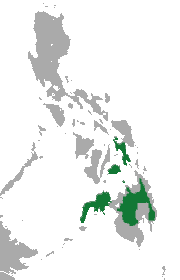| Musaraña de Mindanao | ||
|---|---|---|
 | ||
| Estado de conservación | ||
 Preocupación menor (UICN 3.1)[1] | ||
| Taxonomía | ||
| Reino: | Animalia | |
| Filo: | Chordata | |
| Clase: | Mammalia | |
| Orden: | Eulipotyphla | |
| Familia: | Soricidae | |
| Género: | Crocidura | |
| Especie: |
C. beatus Miller, 1910 | |
| Distribución | ||
 Distribución de la musaraña de Mindanao | ||
Crocidura beatus, musaraña de Mindanao, es una especie de mamífero soricomorfo de la familia Soricidae, endémica de Filipinas.[1]
Es una especie terrestre que habita bosques primarios y secundarios y matorral con bosques próximos.
Su estatus en la Lista Roja de la UICN es de «preocupación menor» ya que su rango de distribución y sus poblaciones son amplias. Se encuentra en las islas de Biliran, Bohol, Camiguín, Leyte, Maripipi y Mindanao, sobre todo en altitudes medias.
Localmente se puede encontrar amenazada debido a la deforestación para establecer explotaciones agrícolas, industrias de madera y asentamientos humanos.[1]
Referencias
- ↑ a b c Heaney, L., Tabaranza, B. & Ruedas, L. (2008). «Crocidura beatus». Lista Roja de especies amenazadas de la UICN 2013.2 (en inglés). ISSN 2307-8235. Consultado el 9 de enero de 2014.
Bibliografía
- Corbet, G.B. & Hill, J.E., 1991. A World List of Mammalian Species. Tercera edición. Natural History Museum Publications & Oxford University Press, Londres y Oxford: v-viii, 1-243.
- Heaney, L. R., Heideman, P. D., Rickart, E. A., Utzurrum, R. B. y Klompen, J. S. H., 1989. Elevational zonation of mammals in the central Philippines. Journal of Tropical Ecology 5: 259-280.
- Heaney, L. R. y Ruedi, M., 1994. A preliminary analysis of biogeography and phylogeny of Crocidura from the Philippines. A: J. E. Meritt, G. L. Kirkland y R. K. Rose (eds), Advances in the Biology of Shrews, pp. 357-377. Carnegie Museum of Natural History, Pittsburgh, Estados Unidos.
- Heaney, L. R., Balete, D. S., Dolar, M. L., Alcala, A. C., Dans, A. T. L., Gonzales, P. C., Ingle, N. R., Lepiten, M. V., Oliver, W. L. R., Ong, P. S., Rickart, E. A., Tabaranza Jr., B. R. y Utzurrum, R. C. B., 1998. A synopsis of the Mammalian Fauna of the Philippine Islands. Fieldiana: Zoology 88: 1-61.
- Heaney, L. R., Tabaranza Jr., B. R., Balete, D. S. y Rigertas, N., 2006. Synopsis and Biogeography of the Mammals of Camiguin Island, Philippines. Fieldiana Zoology 106: 28-48.
- Heaney, L. R., Tabaranza Jr., B., Rickart, E. A., Balete, D. S. y Ingle, N. R., 2006. The Mammals of Mt. Kitanglad Nature Park, Mindanao, Philippines. Fieldiana: Zoology 112: 1-63.
- Hutterer, R., 1993. Order Insectivora. A: Wilson, D.E. & Reeder, D.M. (eds.) Mammal Species of the World. Segunda edición. Smithsonian Institution Press, Washington DC y Londres: 69-130.
- Rickart, E. A., Heaney, L. R., Heidman, P. D. y Utzurrum, R. C. B., 1993. The distribution and ecology of mammals on Leyte, Biliran, and Maripipi islands, Philippines. Fieldiana: Zoology 72: 1-62.
Enlaces externos
 Wikimedia Commons alberga una categoría multimedia sobre Crocidura beatus.
Wikimedia Commons alberga una categoría multimedia sobre Crocidura beatus. Wikispecies tiene un artículo sobre Crocidura beatus.
Wikispecies tiene un artículo sobre Crocidura beatus.
- Animal Diversity Web (en inglés)
- UNEP-WCMC Species Database (enlace roto disponible en Internet Archive; véase el historial, la primera versión y la última). (en inglés)
- NCBI (en inglés)
- Catalogue of Life (enlace roto disponible en Internet Archive; véase el historial, la primera versión y la última). (en inglés)
- Encyclopedia of Life (en inglés)
- ITIS (en inglés)
